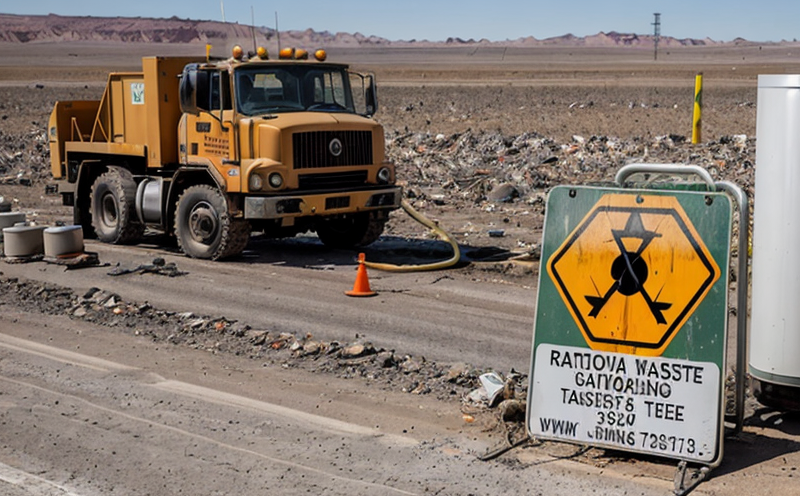ISO 18589-17 Integrated Testing for Waste Site Characterization
The ISO 18589-17 standard provides a comprehensive framework for the integrated testing of radioactive waste sites. This service is critical in ensuring that all relevant parameters are accurately assessed, thereby facilitating informed decisions regarding site characterization and management.
At its core, this service involves a series of tests designed to characterize hazardous waste based on their radioactivity levels and potential environmental impacts. The standard integrates various analytical techniques and methodologies aimed at providing an accurate profile of the waste. This ensures that regulatory compliance is met while also supporting informed decision-making processes in environmental remediation.
The process begins with thorough site evaluation, including preliminary surveys to identify potential areas of concern. Samples are then collected from these identified zones for detailed analysis. These samples undergo a range of tests aimed at quantifying the levels of radionuclides present and assessing their form (e.g., soluble vs insoluble).
Once the samples have been analyzed, results are interpreted in light of international standards such as ISO 18589-17. This involves not just measuring the concentration of specific radionuclides but also considering factors like decay series, half-lives, and potential for bioaccumulation. The goal is to provide a holistic view of the waste's characteristics, which can then inform strategies for safe handling and disposal.
Furthermore, this service extends beyond mere analysis; it includes recommendations on appropriate storage solutions, treatment methods, and disposal routes based on the findings. For instance, if certain radionuclides are found in high concentrations or pose significant risks to human health and the environment, more stringent containment measures may be advised.
The implementation of ISO 18589-17 ensures that all stakeholders involved—whether they are regulatory bodies, waste management companies, or research institutions—are working towards consistent and reliable results. This standardization is crucial given the complex nature of radioactive materials and their diverse impacts on different environments.
In summary, this service offers a robust approach to characterizing hazardous waste sites using ISO 18589-17. By leveraging advanced analytical techniques and adhering strictly to international standards, we ensure that our clients receive accurate, reliable data that can be used effectively in various contexts.
Applied Standards
| Standard Reference | Description |
|---|---|
| ISO 18589-17 | This standard provides a comprehensive framework for the integrated testing of radioactive waste sites. |
| ASTM D3626 | Involves testing and analysis of solid radioactive waste. |
| EN 15279:2008 | Details procedures for the characterization of landfills containing hazardous waste, including those with radioactivity. |
| IEC 62346-1 | Covers basic principles and requirements for the management of radioactive waste. |
| ISO 8579:2003 | Guidelines on sampling strategies for radioactive materials. |
| DOE Order 436.1 | Department of Energy guidelines applicable to the management and treatment of radioactive waste. |
The application of these standards ensures that our testing processes are both rigorous and compliant with international best practices, thus providing accurate data for informed decision-making regarding radioactive waste management.
Quality and Reliability Assurance
Our commitment to quality is unwavering. We employ state-of-the-art equipment and methodologies that adhere strictly to ISO 18589-17 guidelines, ensuring precise measurements and reliable results. Our laboratories are equipped with advanced instrumentation capable of detecting even trace amounts of radionuclides, which is crucial given the minute concentrations often found in radioactive waste.
Each sample undergoes multiple checks at every stage from collection to final analysis to minimize errors. This multi-step process includes preliminary screening followed by detailed quantitative and qualitative analyses. Our team of experts continuously monitors these processes to ensure they meet or exceed ISO 18589-17 requirements.
In addition, we maintain strict quality control protocols throughout the entire testing lifecycle. Regular calibration checks are conducted on all instruments used in our laboratory, ensuring their accuracy remains consistent over time. Furthermore, internal audits and external accreditation reviews further reinforce our commitment to maintaining high standards of quality and reliability.
By adhering strictly to these rigorous procedures, we guarantee that every test result is accurate and can be relied upon for critical decisions related to radioactive waste management. This ensures compliance with relevant regulations while also supporting sustainable practices within the industry.
International Acceptance and Recognition
The ISO 18589-17 standard has gained widespread recognition globally due to its comprehensive approach to characterizing radioactive waste sites. Many countries have adopted this standard as part of their national regulations governing the management, treatment, and disposal of hazardous materials.
For instance, several European Union member states use ISO 18589-17 as a basis for implementing local directives on nuclear safety and radiation protection. Similarly, regulatory bodies in North America have incorporated elements of this standard into their own frameworks for managing radioactive waste.
The acceptance of ISO 18589-17 extends beyond governmental organizations; it is also embraced by private sector entities involved in environmental remediation projects or those responsible for decommissioning nuclear facilities. These companies rely on the standardized testing procedures outlined by this international standard to ensure consistency and reliability across different regions.
Moreover, adherence to ISO 18589-17 enhances credibility among stakeholders such as regulatory authorities, investors, and community groups who need assurance that appropriate measures are being taken regarding radioactive waste management. This recognition contributes significantly to fostering trust in both public and private sectors alike.





